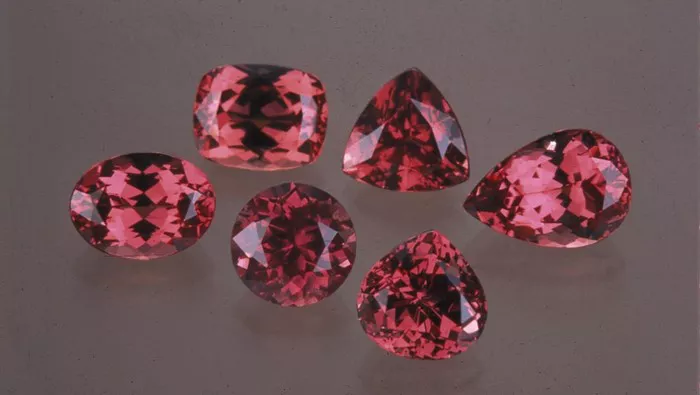Magenta garnet, a captivating gemstone, stands out for its vibrant color and unique properties. This article delves into the world of magenta garnet, exploring its geological formation, characteristics, uses, and significance in both gemology and culture. The aim is to provide an engaging and informative overview that appeals to both enthusiasts and professionals alike.
What is Magenta Garnet?
Magenta garnet is a member of the garnet family, specifically classified under the pyrope-almandine series. Garnets are silicate minerals that crystallize in the cubic system, and they are known for their diverse colors and compositions. Magenta garnet exhibits a striking purplish-red hue, which is a result of the presence of manganese and iron in its chemical structure. This gemstone is often confused with rubies and other red stones, but its unique color and properties set it apart.
Chemical Composition
The chemical formula for garnets is generally represented as $$ X_3Y_2(SiO_4)_3 $$, where $$ X $$ can be various cations such as magnesium, iron, or manganese, and $$ Y $$ can include aluminum, iron, or chromium. In the case of magenta garnet, the presence of manganese is particularly significant as it contributes to the gemstone’s distinctive color.
Color Variations
While magenta garnet is primarily recognized for its vivid magenta hue, it can also display variations that range from deep purples to lighter pinks. The intensity of the color is influenced by the concentration of manganese and iron within the crystal structure.
Geological Formation of Magenta Garnet
Understanding the geological processes that lead to the formation of magenta garnet provides insight into its rarity and value. Garnets typically form in high-temperature and high-pressure environments, often associated with metamorphic rocks.
Formation Process
1. Metamorphism: Magenta garnet forms primarily through metamorphism, where existing rocks undergo changes due to heat and pressure. This process can occur in various geological settings, including mountain ranges and areas of tectonic activity.
2. Parent Rocks: The parent rocks, or protoliths, from which garnets form are often schists or gneisses. The minerals within these rocks react under metamorphic conditions, leading to the crystallization of garnets.
3. Crystallization: As the temperature and pressure conditions stabilize, garnet crystals grow within the rock matrix. The presence of specific elements, such as manganese, during this process is crucial for developing the magenta color.
Locations of Occurrence
Magenta garnet is relatively rare compared to other garnet varieties. Notable deposits can be found in regions with significant metamorphic activity, including:
East Africa: Countries like Tanzania and Madagascar are known for producing high-quality magenta garnets.
India: The state of Rajasthan has been recognized for its vibrant garnet deposits.
United States: Some occurrences can be found in the Appalachian region.
Physical and Optical Properties
The allure of magenta garnet is not only in its color but also in its physical and optical properties, which make it a desirable choice for jewelry and decorative items.
Hardness and Durability
On the Mohs scale of mineral hardness, garnets rank between 6.5 and 7.5, making them relatively durable and suitable for various types of jewelry. This hardness allows magenta garnet to withstand everyday wear, though care should still be taken to avoid scratches and impacts.
Refractive Index
The refractive index of magenta garnet typically ranges from 1.72 to 1.76, contributing to its brilliance and sparkle. This property is essential for gem cutters and jewelers, as it influences how light interacts with the gemstone.
Pleochroism
Magenta garnet exhibits weak pleochroism, meaning that the color may appear different when viewed from various angles. This characteristic can enhance the visual appeal of the gemstone, making it more dynamic in jewelry settings.
See Also: Where is Green Garnet Found?
Uses of Magenta Garnet
Magenta garnet is utilized in various applications, ranging from jewelry to industrial uses.
Jewelry
Magenta garnet is increasingly popular in jewelry design due to its striking color and durability. It is often set in rings, earrings, necklaces, and bracelets, appealing to both modern and traditional tastes.
Design Trends
Contemporary Jewelry: Designers often incorporate magenta garnet in minimalist settings, allowing the gemstone’s color to take center stage.
Vintage Styles: The rich hue of magenta garnet complements vintage-inspired designs, often paired with gold or silver settings.
Industrial Applications
Beyond its aesthetic appeal, garnets are also used in industrial applications. Due to their hardness, they are utilized as abrasives in sandblasting and waterjet cutting. The unique properties of garnet make it an effective material for these purposes.
Cultural Significance
Garnets have held cultural significance throughout history, including magenta garnet. They are often associated with various meanings and symbolism.
Historical Context
In ancient cultures, garnets were believed to possess protective properties. They were used as talismans and amulets, thought to bring safety and good fortune to their wearers.
Modern Symbolism
In contemporary society, magenta garnet is often associated with love, passion, and emotional healing. It is sometimes gifted on anniversaries or special occasions to symbolize deep affection.
Care and Maintenance
To preserve the beauty and integrity of magenta garnet, proper care and maintenance are essential.
Cleaning
Magenta garnet can be cleaned using warm soapy water and a soft brush. Avoid harsh chemicals and ultrasonic cleaners, as these can damage the stone.
Storage
When not in use, store magenta garnet jewelry in a soft pouch or lined box to prevent scratches. Keeping it separate from other gemstones is advisable to avoid abrasion.
Conclusion
Magenta garnet is a stunning gemstone that captivates with its vibrant color and unique properties. Its geological formation, physical characteristics, and cultural significance contribute to its allure in both the gemology community and among jewelry enthusiasts. As interest in this remarkable stone continues to grow, understanding its qualities and care will ensure that magenta garnet remains a cherished addition to any collection.
In summary, magenta garnet is more than just a beautiful gemstone; it is a testament to the intricate processes of nature and the enduring appeal of precious stones in human culture.


